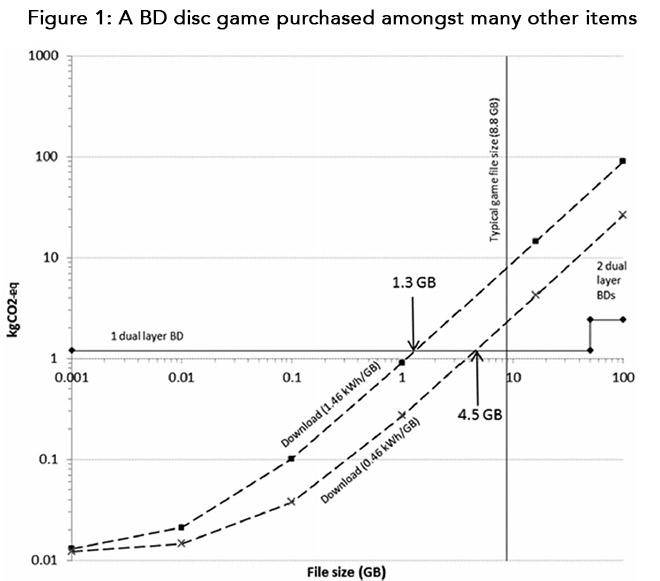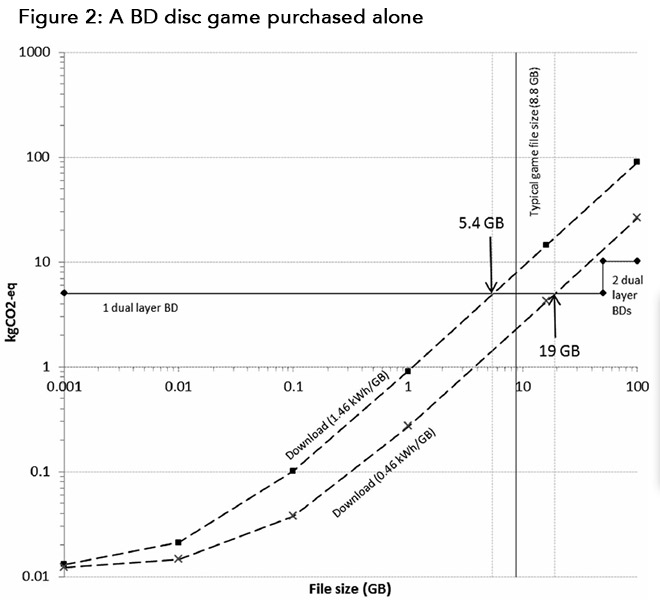Europe's online source of news, data & analysis for professionals involved in packaged media and new delivery technologies

Carbon footprint of games distribution - advantage packaged media
In the context of the climate change debate, the ecological footprint generated by industrial activities has become, of late, a subject of scholarly examination and regulatory attention in several countries. The production and delivery of home entertainment products is no exception. Six academics have just published a research "The Carbon Footprint of Games Distribution," in the Journal of Industrial Ecology, that compares the carbon footprint of videogames distributed on Blu-ray discs versus those accessed on the Internet, using the example of PlayStation 3 in the UK. The results challenge the commonly-accepted view that Internet downloading generates a lower carbon footprint, and thus impacts less on climate change than games purchased on packaged media (DVD and BD).
Console-based gaming has undergone a rapid expansion since the original PlayStation was launched in 1994, remind the authors. It became the first console to hit the oft-quoted benchmark of 100 million cumulative sales worldwide toward the end of its life cycle in 2004. By November 2013, cumulative sales of high-definition consoles (including Sony's PS3, Microsoft's Xbox360, and Nintendo's WiiU) were 165 million units worldwide, almost half of which were PS3. The story continues with the launch of Sony's PlayStation 4 and Microsoft's Xbox One next-generation consoles in November 2013. As a consequence, the energy use of games consoles has attracted increasing attention from environmental groups, prompting various legislatures to consider specific energy efficiency measures (the European Union, the United States, Australia, and New Zealand).
Most major console game releases are now available either to download online or purchase on BDs from retailers (either by ordering online or buying in-store). At the time of this writing (October 2013), file sizes of the top-ten selling videogames in Europe ranged between 1.3GB and 24GB per title, with an average of 11GB. This average size is larger than the average for 2010 of 8.8GB.
The focus of the study is on the videogame titles. The embedded CO2 emissions from the manufacture and distribution of PS3 consoles themselves are excluded because they are equivalent between scenarios.
Blu-ray assumptions
- Carbon emissions arising from the electronic transfer of one master copy of each game from the studio for production are negligible, compared to the number of units of each game produced.
- Lorries are unlikely to be fully utilized on return journeys. It is assumed therefore that half of all returning transport will be empty.
- Transport distance from Austria (where Sony DADC plant is located) to the UK is all by road (representing an extreme case for continental Europe).
- Wooden pallets and shipping boxes used for BD distribution will not be reused or recycled by retailers.
- Consumers will buy discs from retail outlets along with only nine other items. In practice, they may purchase a single game (subsequent to the launch of a new game) or many more items (such as during a trip to a supermarket) in which case emissions are allocated across all of the purchases. There appears to be little reliable data on average numbers of items purchased by consumers during any shopping trip, and types of retail outlets differ widely.
- Shoppers will travel by car to retail outlets.
Download assumptions
- Browsing the online store for a downloadable game will be at a data rate of 50 kilobytes per minute over 10 minutes (based on checks conducted browsing online retail websites by one of the authors).
- Consumers turn off their television (which is normally on when the console is in gameplay mode) while downloading a game.
- Games are usually downloaded in the background while the console is used primarily for other purposes. Because average on-time for each PS3 is 1.9 hours per day files taking longer than this to download, on average, will result in consoles being left on until complete.
- Average distance from household to incineration or landfill is 50 kilometers (to reflect that landfill or incineration facilities usually are commissioned to serve local municipal geographies, such as county councils in the UK).
- To calculate game usage by first users it is assumed that one half of disc games are reused once, that average gameplay time is representative of both first and subsequent use (reuse), and that, in 2010, 95% of games were distributed by disc (which are reasonable assumptions based on discussions with industry experts).
Impacts of various uncertainties in the assumptions
- Reducing the energy intensity of the Internet by half had a proportionate impact on carbon emissions of download. Internet energy efficiency is no longer likely to double every 2 years. In addition, the capacity of BD discs has quadrupled between 2006 and 2013 (a doubling time of 3.5 years), allowing for larger game sizes, for example, new PS4 titles average 16GB. Efficiency of disc production is also expected to have improved by approximately 5% to 10% per year. Because of these, the future relationship between the carbon emissions of downloading games and that for producing and distributing BDs is difficult to predict with certainty.
- The carbon emissions of games distributed by BDs are highly sensitive to the energy used by consumers traveling to shops. If consumers purchase games along with many other items during a major shopping trip (e.g., 100 items), or use public transport to travel to the shops, the carbon emissions of BD production and distribution are between one quarter and one third lower (Figure 1). On the other hand, if consumers drive to the store specifically to buy a game (e.g., following a new game launch), then emissions for BDs fall between lower and upper estimates for downloading. To put this in context, games of 5.40GB to 19GB purchased as the sole item during a shopping trip would have carbon emissions in the same range as that for a download (Figure 2).
- Console electricity use during download only accounts for a small proportion of estimated emissions (e.g., less than 0.1% for a 25GB file). Assuming average peaktime Internet speeds, users are only likely to leave their consoles on to complete a download for files of 17GB or larger.
- For games production, distribution, and use in continental Europe, shops are likely to be closer to the production facility in Sony DADC's Austrian plant than in the UK (reduced from 2,250 to 500 km for the sensitivity analysis), and also carbon equivalent emissions of electricity generation are, on average, lower. In this case for the EU, the life cycle carbon emissions of gaming would be reduced by approximately one third for all scenarios. The carbon impact of producing and distributing an average-sized game on a BD remains, as for the UK, below that of downloading.
- If reuse accounted for either half or double the total usage of each game over its lifetime, it would have a proportionate inverse impact on average gameplay usage time of 'first use,' which would not change the findings of the study.
OVERALL COMPARISON OF GAME DOWNLOAD AND BLU-RAY DISC DISTRIBUTION<


GB = gigabyte; kwh/GB = kilowatt-hours per gigabyte; kg CO2-eq = kilograms carbon dioxide equivalents.
Downloaded compared to Blu-ray Disc videogames
The authors calculated that the carbon footprint of the life-cycle of a downloaded 8.80GB game amounted to 21.9 to 27.5kg CO2 (for lower and upper bounds of Internet energy intensity), whereas the result for a BD game was 20.8kg CO2. Gameplay accounted for 19.5kg CO2 emissions in both scenarios.
For ease of comparison, game development and gameplay are excluded because they are equivalent between scenarios. The carbon footprint of downloading games varies in proportion to file size. In comparison, there is no proportional relationship between carbon emissions of BD and file size. Each dual-layer BD disc can hold up to 50GB, and so any game file larger than this would require more than one BD disc (unless multilayer BDs of 100GB become commercially available for use in console gaming). Thus, results for BD follow a stepped progression.
The research highlights two thresholds from these results: Game files of over 4.5GB have lower carbon emissions if distributed by BD disc, compared to downloaded over the Internet, and files of less than 1.3GB have lower emissions, if downloaded in both cases. Between these ranges of file sizes, uncertainty on how to allocate data center energy use results in no clear 'winner.' Only one of the top ten-selling video games available in 2010 on PlayStation Network for download was within this range (Need for Speed: Hot Pursuit at 4.5GB).
Perhaps, contrary to current consensus that downloaded data will result in lower carbon emissions than distribution by disc, producing and distributing an average-sized videogame title by BD disc in 2010 resulted in approximately 50% to 90% less emissions than Internet downloading.
The authors suggest that, overall, practical and financial factors mean that consumers will keep purchasing the overwhelming majority of larger headline videogames titles on Blu-ray discs, perhaps to avoid waiting for download and to be able to sell their games second-hand after use. Smaller game files below 1.3GB (such as rereleased previous-generation titles or minigames) have lower emissions when downloaded than if distributed by BD (and are only available to download anyway).
Authors of the study: Kieren Mayers is an executive in residence at the INSEAD Social Innovation Center in Fontainbleau, France. Jonathan Koomey is a research fellow at the Steyer-Taylor Center for Energy Policy and Finance at Stanford University in Stanford, CA, USA. Rebecca Hall, at the time of writing, was an M.Sc. student at the Center for Environmental Strategy, Guildford, UK. Maria Bauer, at the time of writing, was an environmental officer at Sony DADC, Austria. Chris France is a professor of environmental technology and associate dean for postgraduate research students at the University of Surrey, Guildford, UK. Amanda Webb is a research engineer at the Center for Environmental Strategy at the University of Surrey, studying the energy use of games consoles working with Sony Computer Entertainment Europe, London, UK.
The full article can be downloaded here .
Story filed 07.09.14




















